Cross-Cultural Management Report for Hydro Generation in Tanzania
VerifiedAdded on 2023/01/04
|12
|3353
|32
Report
AI Summary
This report provides a comprehensive analysis of cross-cultural management within Hydro Generation (HG), focusing on a major dam project in Tanzania. It examines the role of organizational culture, referencing Handy’s Culture Model to guide HG's Vice President, Graham Steinberg. The report explores leadership styles, particularly the Situational Leadership Theory, and its application to the challenges faced by Brett Jones in the Tanzanian context. It also addresses motivation and HRM issues, including recruitment, selection, and staff turnover, emphasizing the importance of respecting local culture. The report recommends strategies for improving cross-cultural understanding, leadership effectiveness, and employee motivation to ensure project success. The core of the report focuses on the application of theoretical frameworks to practical problems, offering recommendations for HG to improve its operations in a cross-cultural setting.

Cross Cultural Management
Paraphrase This Document
Need a fresh take? Get an instant paraphrase of this document with our AI Paraphraser
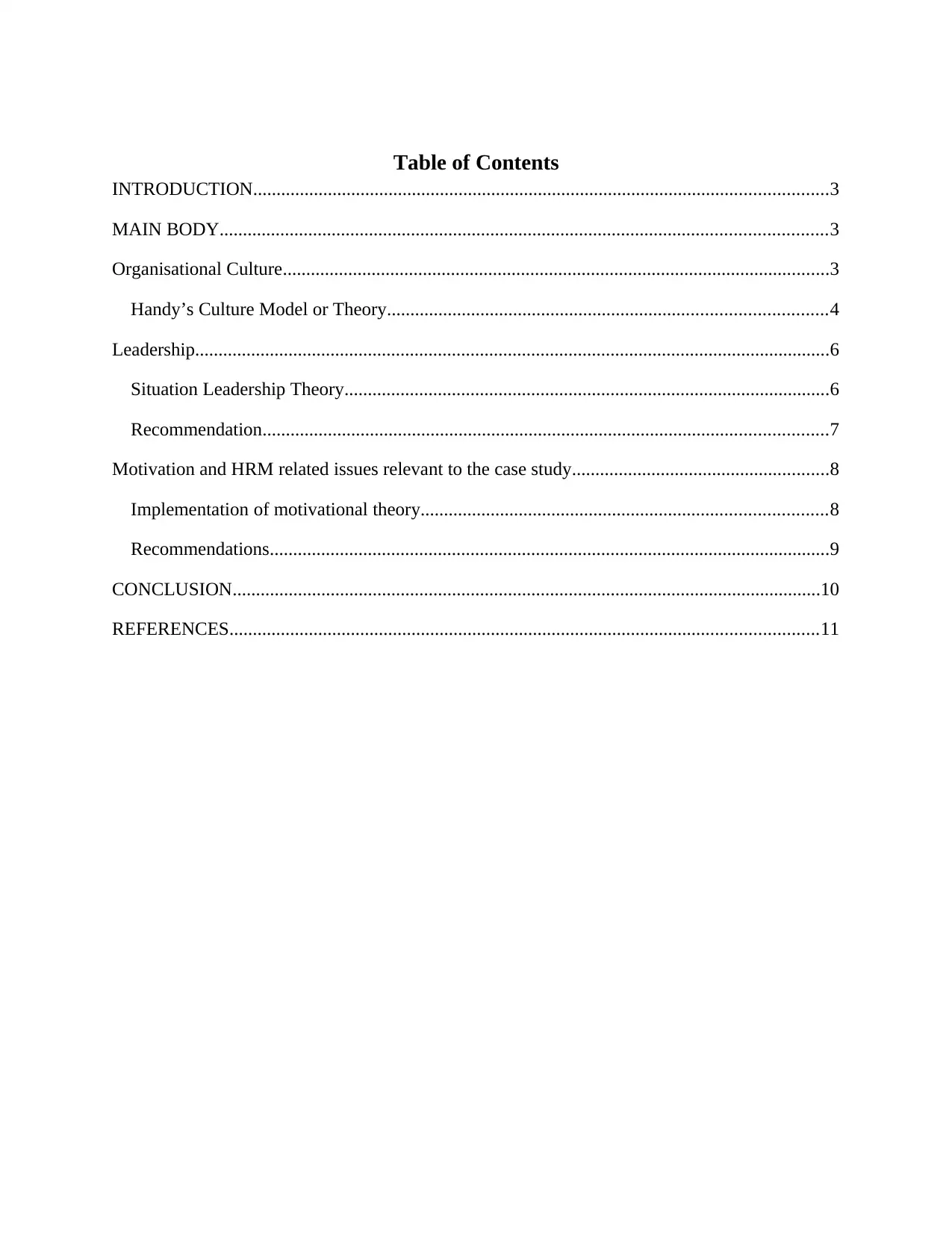
Table of Contents
INTRODUCTION...........................................................................................................................3
MAIN BODY..................................................................................................................................3
Organisational Culture.....................................................................................................................3
Handy’s Culture Model or Theory..............................................................................................4
Leadership........................................................................................................................................6
Situation Leadership Theory........................................................................................................6
Recommendation.........................................................................................................................7
Motivation and HRM related issues relevant to the case study.......................................................8
Implementation of motivational theory.......................................................................................8
Recommendations........................................................................................................................9
CONCLUSION..............................................................................................................................10
REFERENCES..............................................................................................................................11
INTRODUCTION...........................................................................................................................3
MAIN BODY..................................................................................................................................3
Organisational Culture.....................................................................................................................3
Handy’s Culture Model or Theory..............................................................................................4
Leadership........................................................................................................................................6
Situation Leadership Theory........................................................................................................6
Recommendation.........................................................................................................................7
Motivation and HRM related issues relevant to the case study.......................................................8
Implementation of motivational theory.......................................................................................8
Recommendations........................................................................................................................9
CONCLUSION..............................................................................................................................10
REFERENCES..............................................................................................................................11
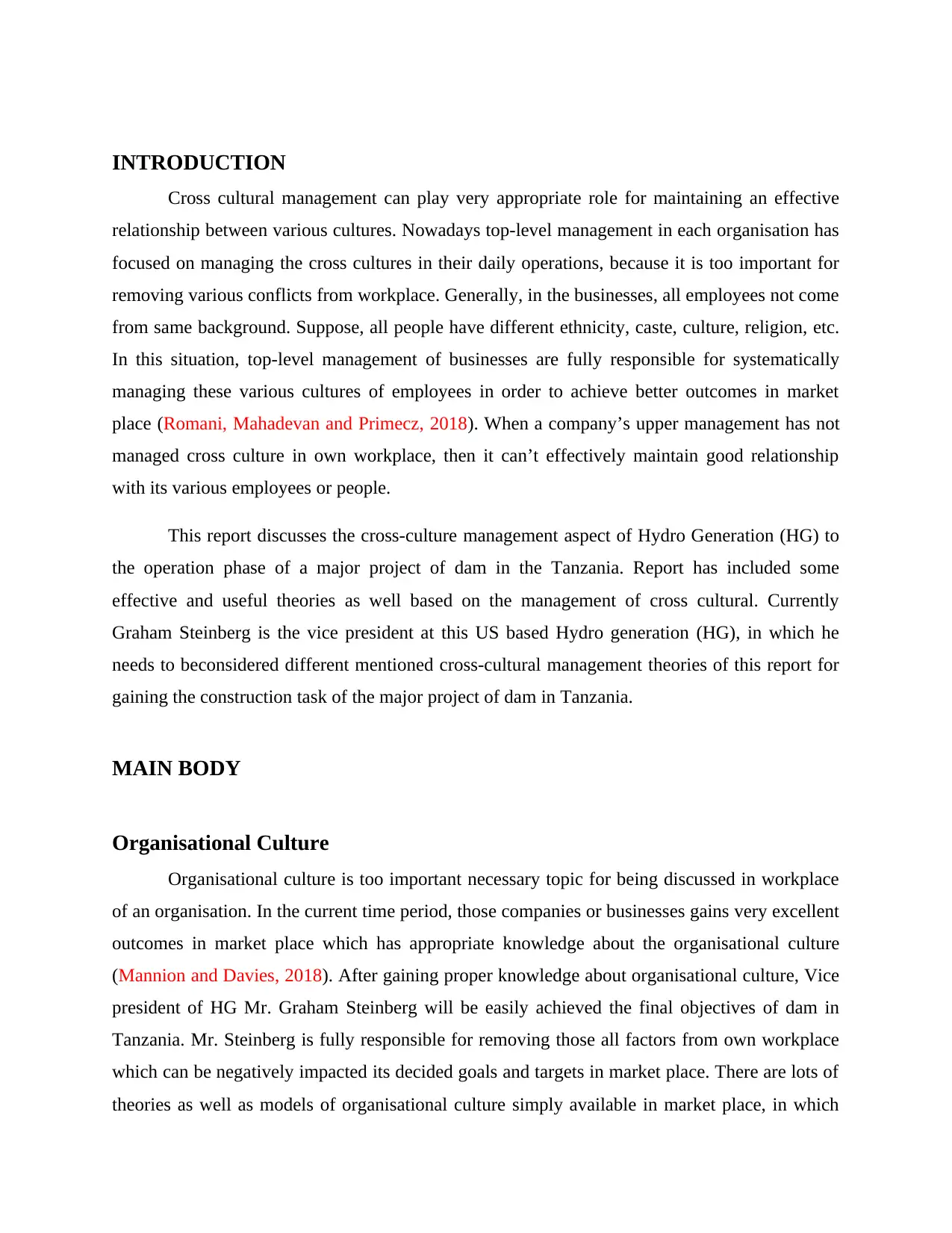
INTRODUCTION
Cross cultural management can play very appropriate role for maintaining an effective
relationship between various cultures. Nowadays top-level management in each organisation has
focused on managing the cross cultures in their daily operations, because it is too important for
removing various conflicts from workplace. Generally, in the businesses, all employees not come
from same background. Suppose, all people have different ethnicity, caste, culture, religion, etc.
In this situation, top-level management of businesses are fully responsible for systematically
managing these various cultures of employees in order to achieve better outcomes in market
place (Romani, Mahadevan and Primecz, 2018). When a company’s upper management has not
managed cross culture in own workplace, then it can’t effectively maintain good relationship
with its various employees or people.
This report discusses the cross-culture management aspect of Hydro Generation (HG) to
the operation phase of a major project of dam in the Tanzania. Report has included some
effective and useful theories as well based on the management of cross cultural. Currently
Graham Steinberg is the vice president at this US based Hydro generation (HG), in which he
needs to beconsidered different mentioned cross-cultural management theories of this report for
gaining the construction task of the major project of dam in Tanzania.
MAIN BODY
Organisational Culture
Organisational culture is too important necessary topic for being discussed in workplace
of an organisation. In the current time period, those companies or businesses gains very excellent
outcomes in market place which has appropriate knowledge about the organisational culture
(Mannion and Davies, 2018). After gaining proper knowledge about organisational culture, Vice
president of HG Mr. Graham Steinberg will be easily achieved the final objectives of dam in
Tanzania. Mr. Steinberg is fully responsible for removing those all factors from own workplace
which can be negatively impacted its decided goals and targets in market place. There are lots of
theories as well as models of organisational culture simply available in market place, in which
Cross cultural management can play very appropriate role for maintaining an effective
relationship between various cultures. Nowadays top-level management in each organisation has
focused on managing the cross cultures in their daily operations, because it is too important for
removing various conflicts from workplace. Generally, in the businesses, all employees not come
from same background. Suppose, all people have different ethnicity, caste, culture, religion, etc.
In this situation, top-level management of businesses are fully responsible for systematically
managing these various cultures of employees in order to achieve better outcomes in market
place (Romani, Mahadevan and Primecz, 2018). When a company’s upper management has not
managed cross culture in own workplace, then it can’t effectively maintain good relationship
with its various employees or people.
This report discusses the cross-culture management aspect of Hydro Generation (HG) to
the operation phase of a major project of dam in the Tanzania. Report has included some
effective and useful theories as well based on the management of cross cultural. Currently
Graham Steinberg is the vice president at this US based Hydro generation (HG), in which he
needs to beconsidered different mentioned cross-cultural management theories of this report for
gaining the construction task of the major project of dam in Tanzania.
MAIN BODY
Organisational Culture
Organisational culture is too important necessary topic for being discussed in workplace
of an organisation. In the current time period, those companies or businesses gains very excellent
outcomes in market place which has appropriate knowledge about the organisational culture
(Mannion and Davies, 2018). After gaining proper knowledge about organisational culture, Vice
president of HG Mr. Graham Steinberg will be easily achieved the final objectives of dam in
Tanzania. Mr. Steinberg is fully responsible for removing those all factors from own workplace
which can be negatively impacted its decided goals and targets in market place. There are lots of
theories as well as models of organisational culture simply available in market place, in which
⊘ This is a preview!⊘
Do you want full access?
Subscribe today to unlock all pages.

Trusted by 1+ million students worldwide
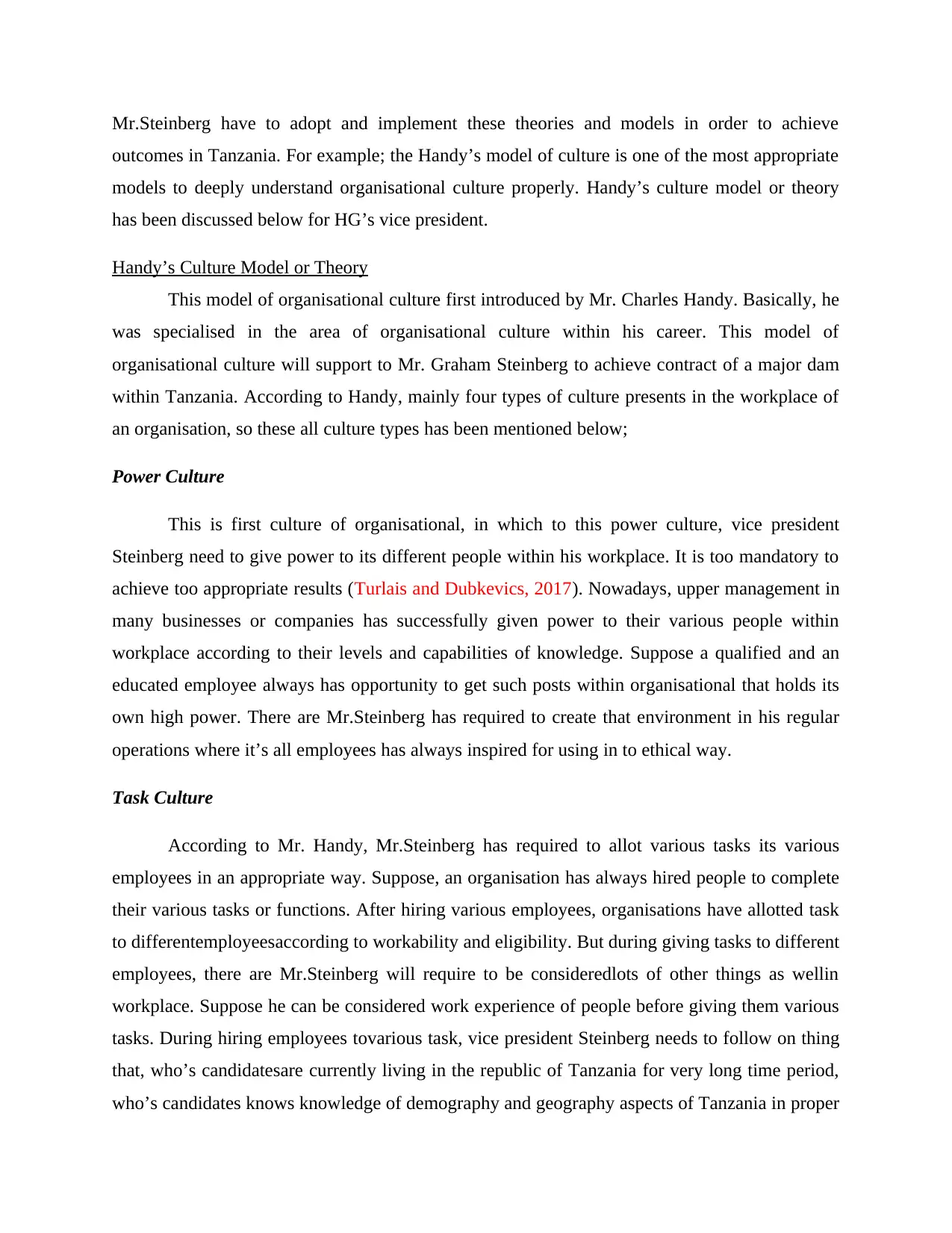
Mr.Steinberg have to adopt and implement these theories and models in order to achieve
outcomes in Tanzania. For example; the Handy’s model of culture is one of the most appropriate
models to deeply understand organisational culture properly. Handy’s culture model or theory
has been discussed below for HG’s vice president.
Handy’s Culture Model or Theory
This model of organisational culture first introduced by Mr. Charles Handy. Basically, he
was specialised in the area of organisational culture within his career. This model of
organisational culture will support to Mr. Graham Steinberg to achieve contract of a major dam
within Tanzania. According to Handy, mainly four types of culture presents in the workplace of
an organisation, so these all culture types has been mentioned below;
Power Culture
This is first culture of organisational, in which to this power culture, vice president
Steinberg need to give power to its different people within his workplace. It is too mandatory to
achieve too appropriate results (Turlais and Dubkevics, 2017). Nowadays, upper management in
many businesses or companies has successfully given power to their various people within
workplace according to their levels and capabilities of knowledge. Suppose a qualified and an
educated employee always has opportunity to get such posts within organisational that holds its
own high power. There are Mr.Steinberg has required to create that environment in his regular
operations where it’s all employees has always inspired for using in to ethical way.
Task Culture
According to Mr. Handy, Mr.Steinberg has required to allot various tasks its various
employees in an appropriate way. Suppose, an organisation has always hired people to complete
their various tasks or functions. After hiring various employees, organisations have allotted task
to differentemployeesaccording to workability and eligibility. But during giving tasks to different
employees, there are Mr.Steinberg will require to be consideredlots of other things as wellin
workplace. Suppose he can be considered work experience of people before giving them various
tasks. During hiring employees tovarious task, vice president Steinberg needs to follow on thing
that, who’s candidatesare currently living in the republic of Tanzania for very long time period,
who’s candidates knows knowledge of demography and geography aspects of Tanzania in proper
outcomes in Tanzania. For example; the Handy’s model of culture is one of the most appropriate
models to deeply understand organisational culture properly. Handy’s culture model or theory
has been discussed below for HG’s vice president.
Handy’s Culture Model or Theory
This model of organisational culture first introduced by Mr. Charles Handy. Basically, he
was specialised in the area of organisational culture within his career. This model of
organisational culture will support to Mr. Graham Steinberg to achieve contract of a major dam
within Tanzania. According to Handy, mainly four types of culture presents in the workplace of
an organisation, so these all culture types has been mentioned below;
Power Culture
This is first culture of organisational, in which to this power culture, vice president
Steinberg need to give power to its different people within his workplace. It is too mandatory to
achieve too appropriate results (Turlais and Dubkevics, 2017). Nowadays, upper management in
many businesses or companies has successfully given power to their various people within
workplace according to their levels and capabilities of knowledge. Suppose a qualified and an
educated employee always has opportunity to get such posts within organisational that holds its
own high power. There are Mr.Steinberg has required to create that environment in his regular
operations where it’s all employees has always inspired for using in to ethical way.
Task Culture
According to Mr. Handy, Mr.Steinberg has required to allot various tasks its various
employees in an appropriate way. Suppose, an organisation has always hired people to complete
their various tasks or functions. After hiring various employees, organisations have allotted task
to differentemployeesaccording to workability and eligibility. But during giving tasks to different
employees, there are Mr.Steinberg will require to be consideredlots of other things as wellin
workplace. Suppose he can be considered work experience of people before giving them various
tasks. During hiring employees tovarious task, vice president Steinberg needs to follow on thing
that, who’s candidatesare currently living in the republic of Tanzania for very long time period,
who’s candidates knows knowledge of demography and geography aspects of Tanzania in proper
Paraphrase This Document
Need a fresh take? Get an instant paraphrase of this document with our AI Paraphraser
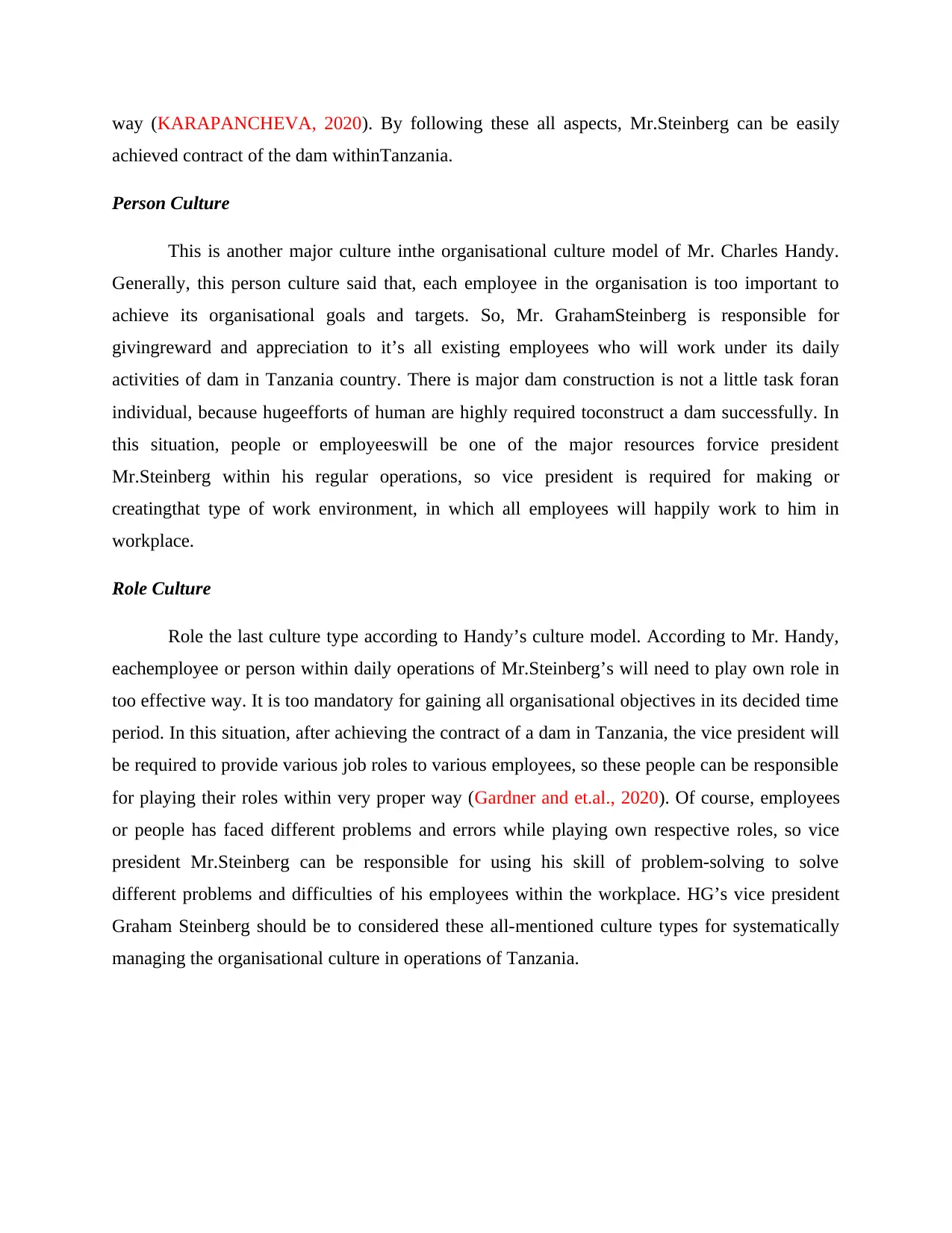
way (KARAPANCHEVA, 2020). By following these all aspects, Mr.Steinberg can be easily
achieved contract of the dam withinTanzania.
Person Culture
This is another major culture inthe organisational culture model of Mr. Charles Handy.
Generally, this person culture said that, each employee in the organisation is too important to
achieve its organisational goals and targets. So, Mr. GrahamSteinberg is responsible for
givingreward and appreciation to it’s all existing employees who will work under its daily
activities of dam in Tanzania country. There is major dam construction is not a little task foran
individual, because hugeefforts of human are highly required toconstruct a dam successfully. In
this situation, people or employeeswill be one of the major resources forvice president
Mr.Steinberg within his regular operations, so vice president is required for making or
creatingthat type of work environment, in which all employees will happily work to him in
workplace.
Role Culture
Role the last culture type according to Handy’s culture model. According to Mr. Handy,
eachemployee or person within daily operations of Mr.Steinberg’s will need to play own role in
too effective way. It is too mandatory for gaining all organisational objectives in its decided time
period. In this situation, after achieving the contract of a dam in Tanzania, the vice president will
be required to provide various job roles to various employees, so these people can be responsible
for playing their roles within very proper way (Gardner and et.al., 2020). Of course, employees
or people has faced different problems and errors while playing own respective roles, so vice
president Mr.Steinberg can be responsible for using his skill of problem-solving to solve
different problems and difficulties of his employees within the workplace. HG’s vice president
Graham Steinberg should be to considered these all-mentioned culture types for systematically
managing the organisational culture in operations of Tanzania.
achieved contract of the dam withinTanzania.
Person Culture
This is another major culture inthe organisational culture model of Mr. Charles Handy.
Generally, this person culture said that, each employee in the organisation is too important to
achieve its organisational goals and targets. So, Mr. GrahamSteinberg is responsible for
givingreward and appreciation to it’s all existing employees who will work under its daily
activities of dam in Tanzania country. There is major dam construction is not a little task foran
individual, because hugeefforts of human are highly required toconstruct a dam successfully. In
this situation, people or employeeswill be one of the major resources forvice president
Mr.Steinberg within his regular operations, so vice president is required for making or
creatingthat type of work environment, in which all employees will happily work to him in
workplace.
Role Culture
Role the last culture type according to Handy’s culture model. According to Mr. Handy,
eachemployee or person within daily operations of Mr.Steinberg’s will need to play own role in
too effective way. It is too mandatory for gaining all organisational objectives in its decided time
period. In this situation, after achieving the contract of a dam in Tanzania, the vice president will
be required to provide various job roles to various employees, so these people can be responsible
for playing their roles within very proper way (Gardner and et.al., 2020). Of course, employees
or people has faced different problems and errors while playing own respective roles, so vice
president Mr.Steinberg can be responsible for using his skill of problem-solving to solve
different problems and difficulties of his employees within the workplace. HG’s vice president
Graham Steinberg should be to considered these all-mentioned culture types for systematically
managing the organisational culture in operations of Tanzania.
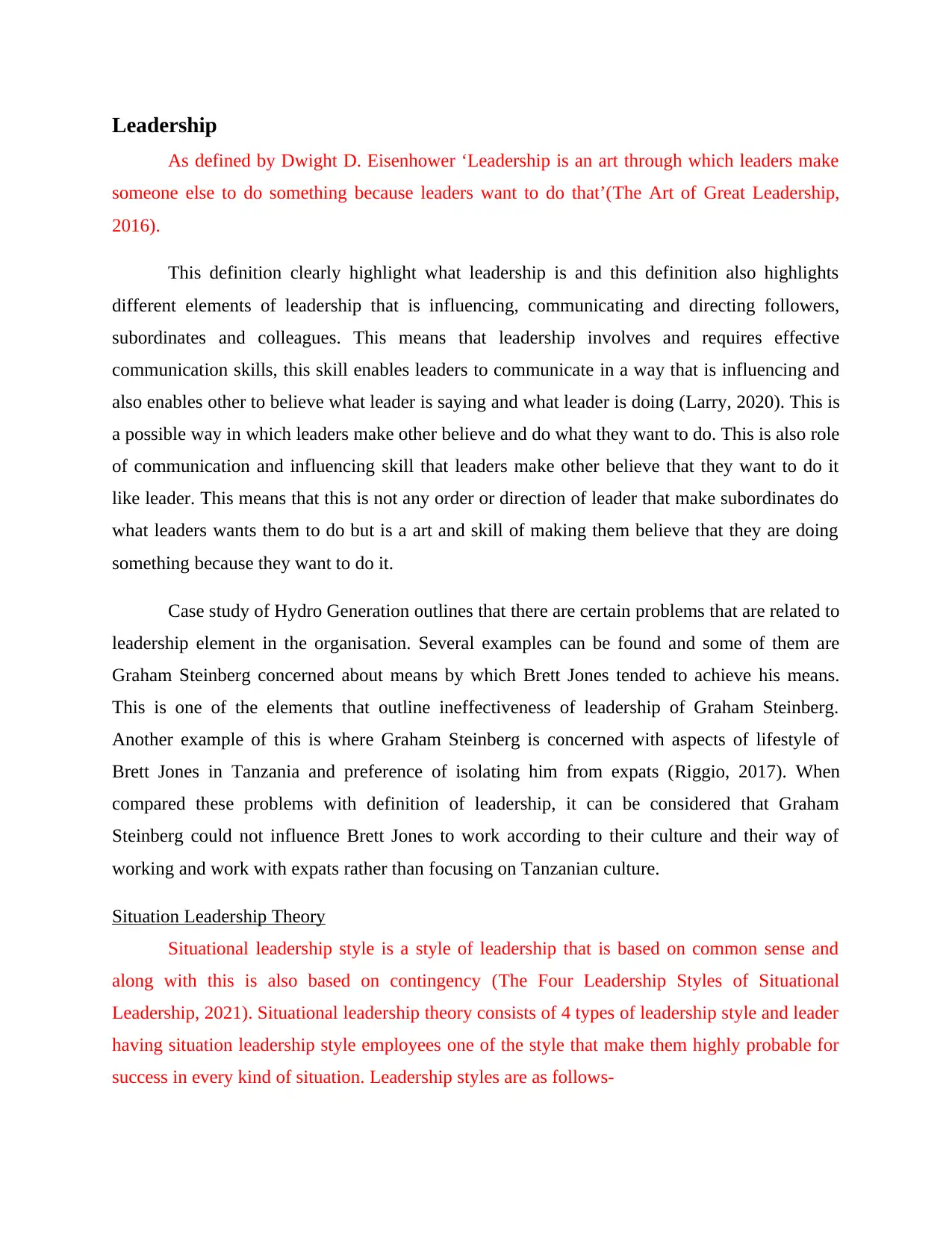
Leadership
As defined by Dwight D. Eisenhower ‘Leadership is an art through which leaders make
someone else to do something because leaders want to do that’(The Art of Great Leadership,
2016).
This definition clearly highlight what leadership is and this definition also highlights
different elements of leadership that is influencing, communicating and directing followers,
subordinates and colleagues. This means that leadership involves and requires effective
communication skills, this skill enables leaders to communicate in a way that is influencing and
also enables other to believe what leader is saying and what leader is doing (Larry, 2020). This is
a possible way in which leaders make other believe and do what they want to do. This is also role
of communication and influencing skill that leaders make other believe that they want to do it
like leader. This means that this is not any order or direction of leader that make subordinates do
what leaders wants them to do but is a art and skill of making them believe that they are doing
something because they want to do it.
Case study of Hydro Generation outlines that there are certain problems that are related to
leadership element in the organisation. Several examples can be found and some of them are
Graham Steinberg concerned about means by which Brett Jones tended to achieve his means.
This is one of the elements that outline ineffectiveness of leadership of Graham Steinberg.
Another example of this is where Graham Steinberg is concerned with aspects of lifestyle of
Brett Jones in Tanzania and preference of isolating him from expats (Riggio, 2017). When
compared these problems with definition of leadership, it can be considered that Graham
Steinberg could not influence Brett Jones to work according to their culture and their way of
working and work with expats rather than focusing on Tanzanian culture.
Situation Leadership Theory
Situational leadership style is a style of leadership that is based on common sense and
along with this is also based on contingency (The Four Leadership Styles of Situational
Leadership, 2021). Situational leadership theory consists of 4 types of leadership style and leader
having situation leadership style employees one of the style that make them highly probable for
success in every kind of situation. Leadership styles are as follows-
As defined by Dwight D. Eisenhower ‘Leadership is an art through which leaders make
someone else to do something because leaders want to do that’(The Art of Great Leadership,
2016).
This definition clearly highlight what leadership is and this definition also highlights
different elements of leadership that is influencing, communicating and directing followers,
subordinates and colleagues. This means that leadership involves and requires effective
communication skills, this skill enables leaders to communicate in a way that is influencing and
also enables other to believe what leader is saying and what leader is doing (Larry, 2020). This is
a possible way in which leaders make other believe and do what they want to do. This is also role
of communication and influencing skill that leaders make other believe that they want to do it
like leader. This means that this is not any order or direction of leader that make subordinates do
what leaders wants them to do but is a art and skill of making them believe that they are doing
something because they want to do it.
Case study of Hydro Generation outlines that there are certain problems that are related to
leadership element in the organisation. Several examples can be found and some of them are
Graham Steinberg concerned about means by which Brett Jones tended to achieve his means.
This is one of the elements that outline ineffectiveness of leadership of Graham Steinberg.
Another example of this is where Graham Steinberg is concerned with aspects of lifestyle of
Brett Jones in Tanzania and preference of isolating him from expats (Riggio, 2017). When
compared these problems with definition of leadership, it can be considered that Graham
Steinberg could not influence Brett Jones to work according to their culture and their way of
working and work with expats rather than focusing on Tanzanian culture.
Situation Leadership Theory
Situational leadership style is a style of leadership that is based on common sense and
along with this is also based on contingency (The Four Leadership Styles of Situational
Leadership, 2021). Situational leadership theory consists of 4 types of leadership style and leader
having situation leadership style employees one of the style that make them highly probable for
success in every kind of situation. Leadership styles are as follows-
⊘ This is a preview!⊘
Do you want full access?
Subscribe today to unlock all pages.

Trusted by 1+ million students worldwide
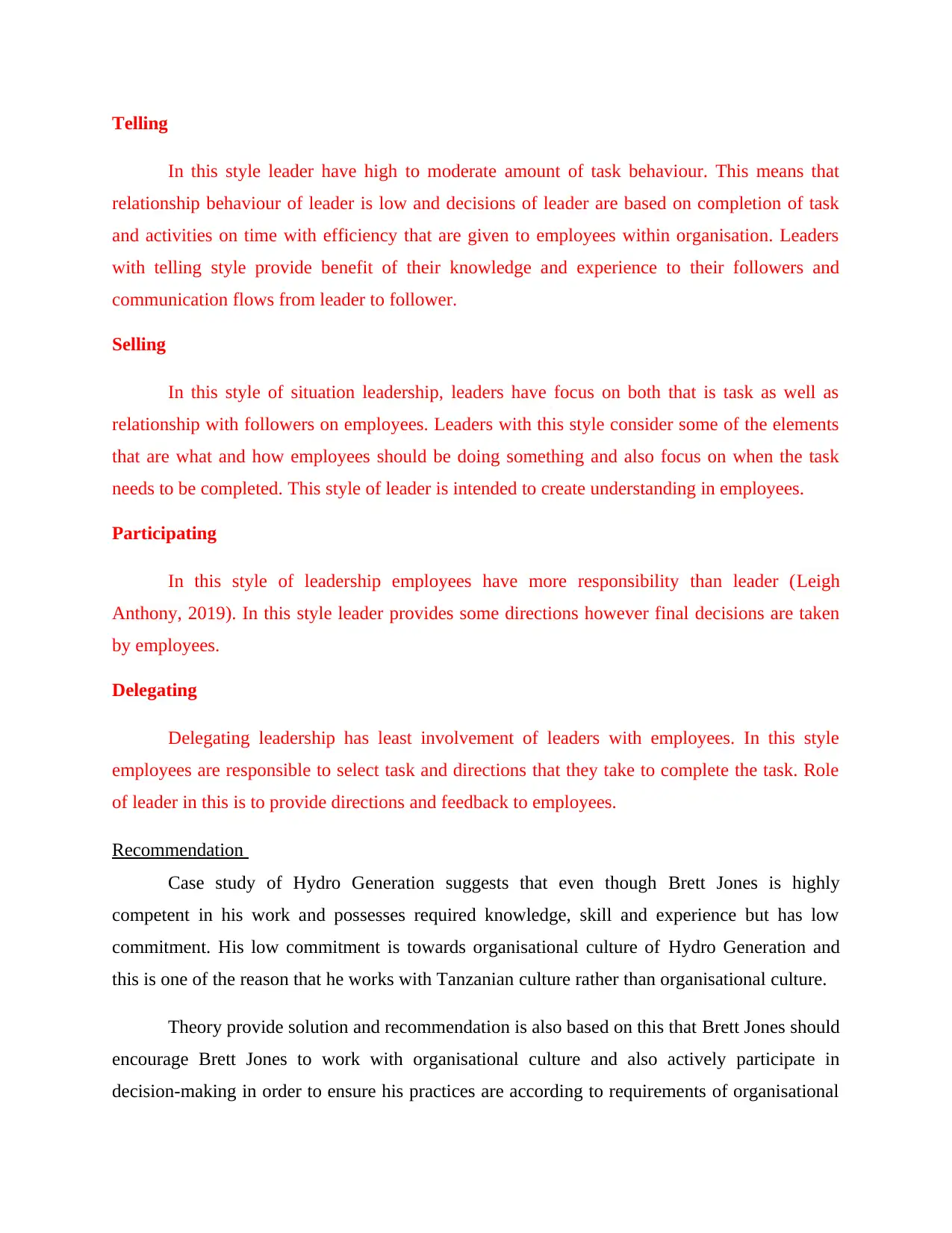
Telling
In this style leader have high to moderate amount of task behaviour. This means that
relationship behaviour of leader is low and decisions of leader are based on completion of task
and activities on time with efficiency that are given to employees within organisation. Leaders
with telling style provide benefit of their knowledge and experience to their followers and
communication flows from leader to follower.
Selling
In this style of situation leadership, leaders have focus on both that is task as well as
relationship with followers on employees. Leaders with this style consider some of the elements
that are what and how employees should be doing something and also focus on when the task
needs to be completed. This style of leader is intended to create understanding in employees.
Participating
In this style of leadership employees have more responsibility than leader (Leigh
Anthony, 2019). In this style leader provides some directions however final decisions are taken
by employees.
Delegating
Delegating leadership has least involvement of leaders with employees. In this style
employees are responsible to select task and directions that they take to complete the task. Role
of leader in this is to provide directions and feedback to employees.
Recommendation
Case study of Hydro Generation suggests that even though Brett Jones is highly
competent in his work and possesses required knowledge, skill and experience but has low
commitment. His low commitment is towards organisational culture of Hydro Generation and
this is one of the reason that he works with Tanzanian culture rather than organisational culture.
Theory provide solution and recommendation is also based on this that Brett Jones should
encourage Brett Jones to work with organisational culture and also actively participate in
decision-making in order to ensure his practices are according to requirements of organisational
In this style leader have high to moderate amount of task behaviour. This means that
relationship behaviour of leader is low and decisions of leader are based on completion of task
and activities on time with efficiency that are given to employees within organisation. Leaders
with telling style provide benefit of their knowledge and experience to their followers and
communication flows from leader to follower.
Selling
In this style of situation leadership, leaders have focus on both that is task as well as
relationship with followers on employees. Leaders with this style consider some of the elements
that are what and how employees should be doing something and also focus on when the task
needs to be completed. This style of leader is intended to create understanding in employees.
Participating
In this style of leadership employees have more responsibility than leader (Leigh
Anthony, 2019). In this style leader provides some directions however final decisions are taken
by employees.
Delegating
Delegating leadership has least involvement of leaders with employees. In this style
employees are responsible to select task and directions that they take to complete the task. Role
of leader in this is to provide directions and feedback to employees.
Recommendation
Case study of Hydro Generation suggests that even though Brett Jones is highly
competent in his work and possesses required knowledge, skill and experience but has low
commitment. His low commitment is towards organisational culture of Hydro Generation and
this is one of the reason that he works with Tanzanian culture rather than organisational culture.
Theory provide solution and recommendation is also based on this that Brett Jones should
encourage Brett Jones to work with organisational culture and also actively participate in
decision-making in order to ensure his practices are according to requirements of organisational
Paraphrase This Document
Need a fresh take? Get an instant paraphrase of this document with our AI Paraphraser
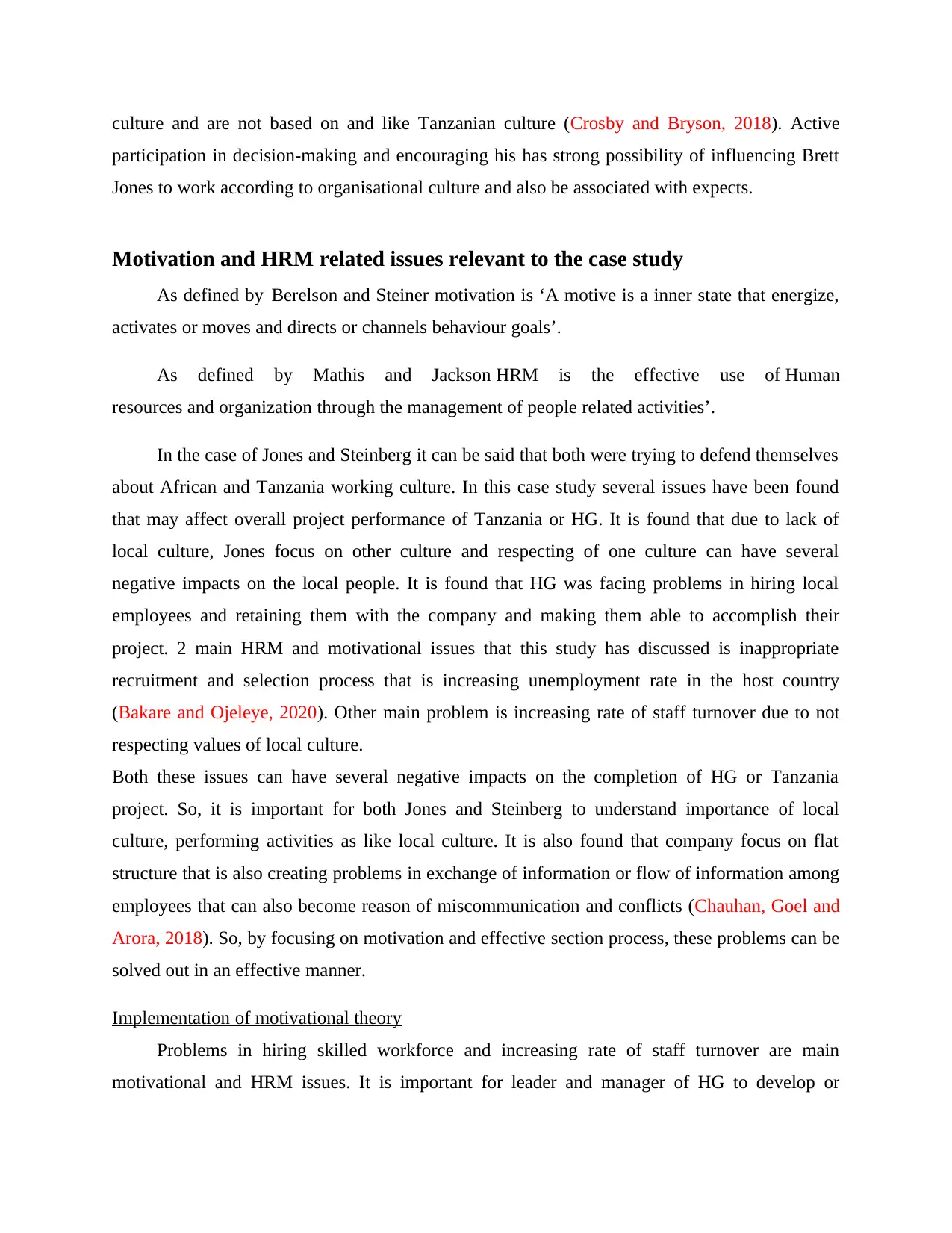
culture and are not based on and like Tanzanian culture (Crosby and Bryson, 2018). Active
participation in decision-making and encouraging his has strong possibility of influencing Brett
Jones to work according to organisational culture and also be associated with expects.
Motivation and HRM related issues relevant to the case study
As defined by Berelson and Steiner motivation is ‘A motive is a inner state that energize,
activates or moves and directs or channels behaviour goals’.
As defined by Mathis and Jackson HRM is the effective use of Human
resources and organization through the management of people related activities’.
In the case of Jones and Steinberg it can be said that both were trying to defend themselves
about African and Tanzania working culture. In this case study several issues have been found
that may affect overall project performance of Tanzania or HG. It is found that due to lack of
local culture, Jones focus on other culture and respecting of one culture can have several
negative impacts on the local people. It is found that HG was facing problems in hiring local
employees and retaining them with the company and making them able to accomplish their
project. 2 main HRM and motivational issues that this study has discussed is inappropriate
recruitment and selection process that is increasing unemployment rate in the host country
(Bakare and Ojeleye, 2020). Other main problem is increasing rate of staff turnover due to not
respecting values of local culture.
Both these issues can have several negative impacts on the completion of HG or Tanzania
project. So, it is important for both Jones and Steinberg to understand importance of local
culture, performing activities as like local culture. It is also found that company focus on flat
structure that is also creating problems in exchange of information or flow of information among
employees that can also become reason of miscommunication and conflicts (Chauhan, Goel and
Arora, 2018). So, by focusing on motivation and effective section process, these problems can be
solved out in an effective manner.
Implementation of motivational theory
Problems in hiring skilled workforce and increasing rate of staff turnover are main
motivational and HRM issues. It is important for leader and manager of HG to develop or
participation in decision-making and encouraging his has strong possibility of influencing Brett
Jones to work according to organisational culture and also be associated with expects.
Motivation and HRM related issues relevant to the case study
As defined by Berelson and Steiner motivation is ‘A motive is a inner state that energize,
activates or moves and directs or channels behaviour goals’.
As defined by Mathis and Jackson HRM is the effective use of Human
resources and organization through the management of people related activities’.
In the case of Jones and Steinberg it can be said that both were trying to defend themselves
about African and Tanzania working culture. In this case study several issues have been found
that may affect overall project performance of Tanzania or HG. It is found that due to lack of
local culture, Jones focus on other culture and respecting of one culture can have several
negative impacts on the local people. It is found that HG was facing problems in hiring local
employees and retaining them with the company and making them able to accomplish their
project. 2 main HRM and motivational issues that this study has discussed is inappropriate
recruitment and selection process that is increasing unemployment rate in the host country
(Bakare and Ojeleye, 2020). Other main problem is increasing rate of staff turnover due to not
respecting values of local culture.
Both these issues can have several negative impacts on the completion of HG or Tanzania
project. So, it is important for both Jones and Steinberg to understand importance of local
culture, performing activities as like local culture. It is also found that company focus on flat
structure that is also creating problems in exchange of information or flow of information among
employees that can also become reason of miscommunication and conflicts (Chauhan, Goel and
Arora, 2018). So, by focusing on motivation and effective section process, these problems can be
solved out in an effective manner.
Implementation of motivational theory
Problems in hiring skilled workforce and increasing rate of staff turnover are main
motivational and HRM issues. It is important for leader and manager of HG to develop or
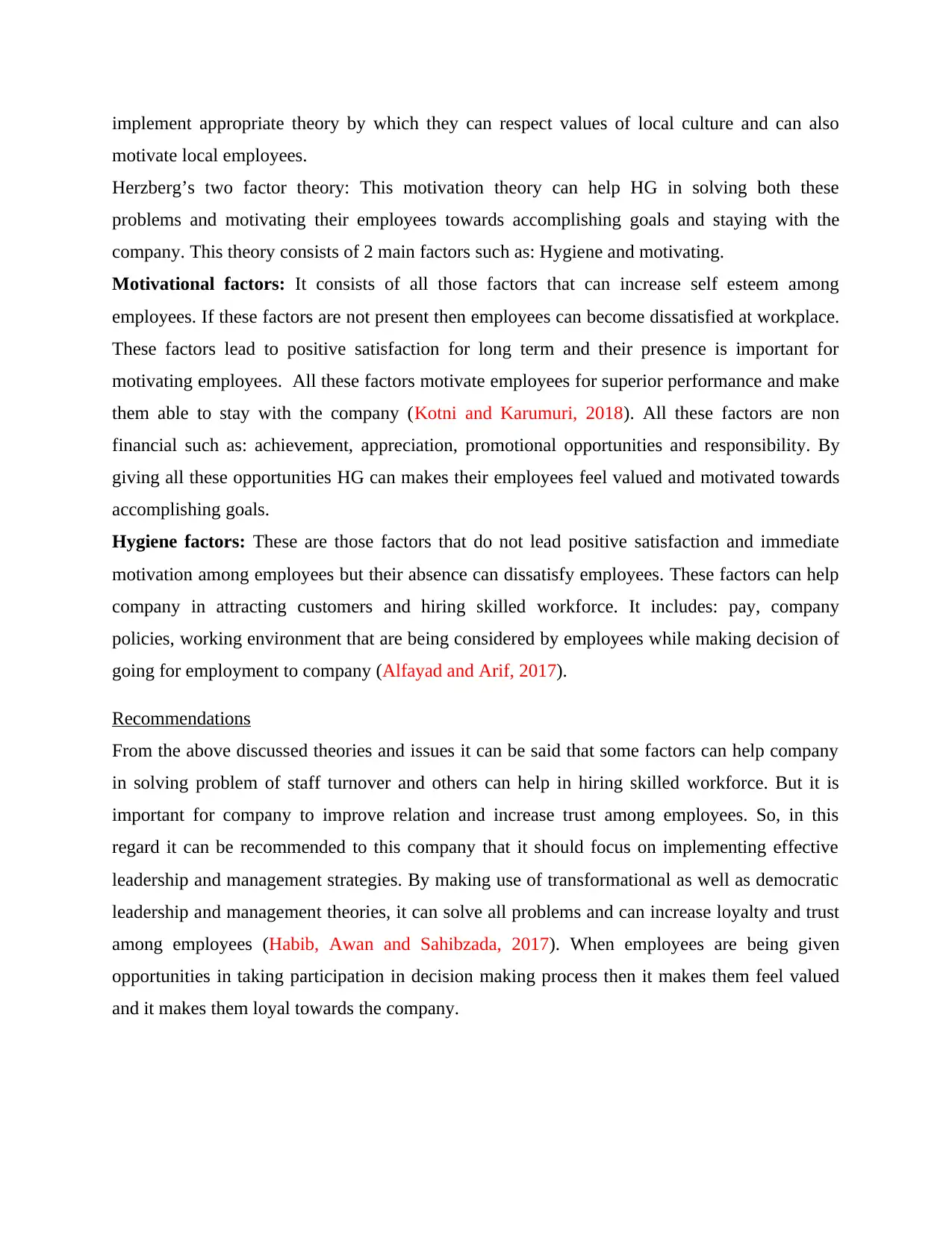
implement appropriate theory by which they can respect values of local culture and can also
motivate local employees.
Herzberg’s two factor theory: This motivation theory can help HG in solving both these
problems and motivating their employees towards accomplishing goals and staying with the
company. This theory consists of 2 main factors such as: Hygiene and motivating.
Motivational factors: It consists of all those factors that can increase self esteem among
employees. If these factors are not present then employees can become dissatisfied at workplace.
These factors lead to positive satisfaction for long term and their presence is important for
motivating employees. All these factors motivate employees for superior performance and make
them able to stay with the company (Kotni and Karumuri, 2018). All these factors are non
financial such as: achievement, appreciation, promotional opportunities and responsibility. By
giving all these opportunities HG can makes their employees feel valued and motivated towards
accomplishing goals.
Hygiene factors: These are those factors that do not lead positive satisfaction and immediate
motivation among employees but their absence can dissatisfy employees. These factors can help
company in attracting customers and hiring skilled workforce. It includes: pay, company
policies, working environment that are being considered by employees while making decision of
going for employment to company (Alfayad and Arif, 2017).
Recommendations
From the above discussed theories and issues it can be said that some factors can help company
in solving problem of staff turnover and others can help in hiring skilled workforce. But it is
important for company to improve relation and increase trust among employees. So, in this
regard it can be recommended to this company that it should focus on implementing effective
leadership and management strategies. By making use of transformational as well as democratic
leadership and management theories, it can solve all problems and can increase loyalty and trust
among employees (Habib, Awan and Sahibzada, 2017). When employees are being given
opportunities in taking participation in decision making process then it makes them feel valued
and it makes them loyal towards the company.
motivate local employees.
Herzberg’s two factor theory: This motivation theory can help HG in solving both these
problems and motivating their employees towards accomplishing goals and staying with the
company. This theory consists of 2 main factors such as: Hygiene and motivating.
Motivational factors: It consists of all those factors that can increase self esteem among
employees. If these factors are not present then employees can become dissatisfied at workplace.
These factors lead to positive satisfaction for long term and their presence is important for
motivating employees. All these factors motivate employees for superior performance and make
them able to stay with the company (Kotni and Karumuri, 2018). All these factors are non
financial such as: achievement, appreciation, promotional opportunities and responsibility. By
giving all these opportunities HG can makes their employees feel valued and motivated towards
accomplishing goals.
Hygiene factors: These are those factors that do not lead positive satisfaction and immediate
motivation among employees but their absence can dissatisfy employees. These factors can help
company in attracting customers and hiring skilled workforce. It includes: pay, company
policies, working environment that are being considered by employees while making decision of
going for employment to company (Alfayad and Arif, 2017).
Recommendations
From the above discussed theories and issues it can be said that some factors can help company
in solving problem of staff turnover and others can help in hiring skilled workforce. But it is
important for company to improve relation and increase trust among employees. So, in this
regard it can be recommended to this company that it should focus on implementing effective
leadership and management strategies. By making use of transformational as well as democratic
leadership and management theories, it can solve all problems and can increase loyalty and trust
among employees (Habib, Awan and Sahibzada, 2017). When employees are being given
opportunities in taking participation in decision making process then it makes them feel valued
and it makes them loyal towards the company.
⊘ This is a preview!⊘
Do you want full access?
Subscribe today to unlock all pages.

Trusted by 1+ million students worldwide
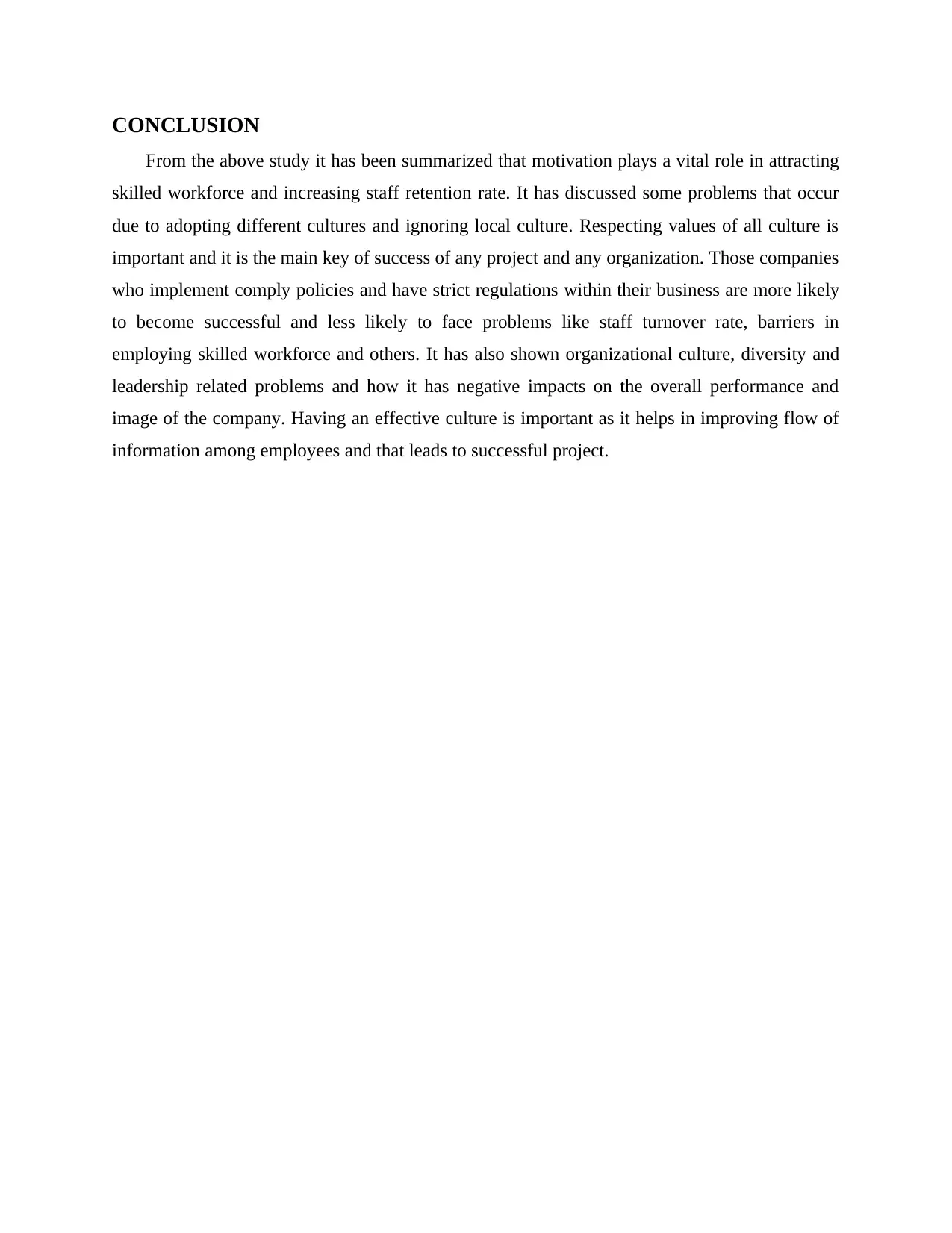
CONCLUSION
From the above study it has been summarized that motivation plays a vital role in attracting
skilled workforce and increasing staff retention rate. It has discussed some problems that occur
due to adopting different cultures and ignoring local culture. Respecting values of all culture is
important and it is the main key of success of any project and any organization. Those companies
who implement comply policies and have strict regulations within their business are more likely
to become successful and less likely to face problems like staff turnover rate, barriers in
employing skilled workforce and others. It has also shown organizational culture, diversity and
leadership related problems and how it has negative impacts on the overall performance and
image of the company. Having an effective culture is important as it helps in improving flow of
information among employees and that leads to successful project.
From the above study it has been summarized that motivation plays a vital role in attracting
skilled workforce and increasing staff retention rate. It has discussed some problems that occur
due to adopting different cultures and ignoring local culture. Respecting values of all culture is
important and it is the main key of success of any project and any organization. Those companies
who implement comply policies and have strict regulations within their business are more likely
to become successful and less likely to face problems like staff turnover rate, barriers in
employing skilled workforce and others. It has also shown organizational culture, diversity and
leadership related problems and how it has negative impacts on the overall performance and
image of the company. Having an effective culture is important as it helps in improving flow of
information among employees and that leads to successful project.
Paraphrase This Document
Need a fresh take? Get an instant paraphrase of this document with our AI Paraphraser
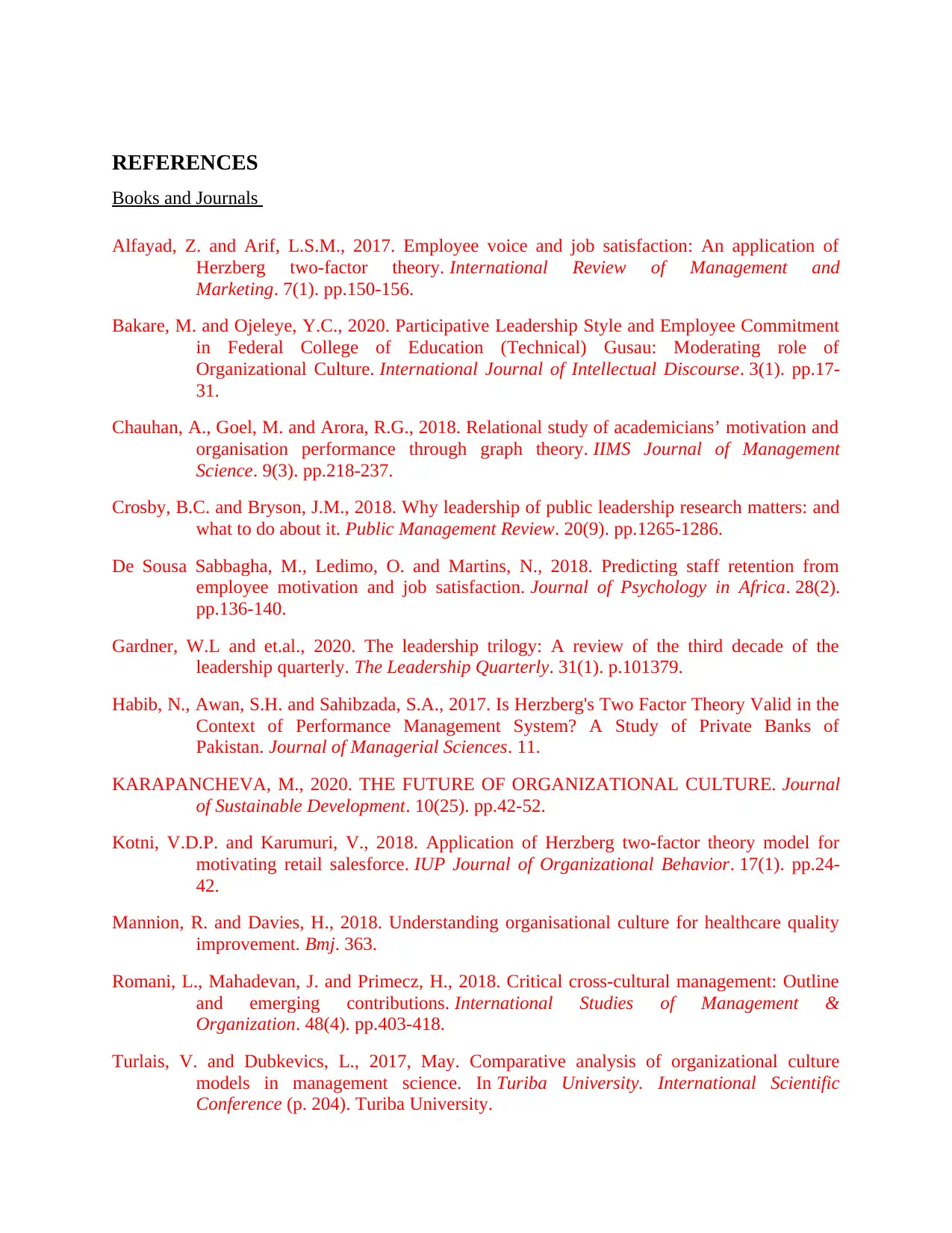
REFERENCES
Books and Journals
Alfayad, Z. and Arif, L.S.M., 2017. Employee voice and job satisfaction: An application of
Herzberg two-factor theory. International Review of Management and
Marketing. 7(1). pp.150-156.
Bakare, M. and Ojeleye, Y.C., 2020. Participative Leadership Style and Employee Commitment
in Federal College of Education (Technical) Gusau: Moderating role of
Organizational Culture. International Journal of Intellectual Discourse. 3(1). pp.17-
31.
Chauhan, A., Goel, M. and Arora, R.G., 2018. Relational study of academicians’ motivation and
organisation performance through graph theory. IIMS Journal of Management
Science. 9(3). pp.218-237.
Crosby, B.C. and Bryson, J.M., 2018. Why leadership of public leadership research matters: and
what to do about it. Public Management Review. 20(9). pp.1265-1286.
De Sousa Sabbagha, M., Ledimo, O. and Martins, N., 2018. Predicting staff retention from
employee motivation and job satisfaction. Journal of Psychology in Africa. 28(2).
pp.136-140.
Gardner, W.L and et.al., 2020. The leadership trilogy: A review of the third decade of the
leadership quarterly. The Leadership Quarterly. 31(1). p.101379.
Habib, N., Awan, S.H. and Sahibzada, S.A., 2017. Is Herzberg's Two Factor Theory Valid in the
Context of Performance Management System? A Study of Private Banks of
Pakistan. Journal of Managerial Sciences. 11.
KARAPANCHEVA, M., 2020. THE FUTURE OF ORGANIZATIONAL CULTURE. Journal
of Sustainable Development. 10(25). pp.42-52.
Kotni, V.D.P. and Karumuri, V., 2018. Application of Herzberg two-factor theory model for
motivating retail salesforce. IUP Journal of Organizational Behavior. 17(1). pp.24-
42.
Mannion, R. and Davies, H., 2018. Understanding organisational culture for healthcare quality
improvement. Bmj. 363.
Romani, L., Mahadevan, J. and Primecz, H., 2018. Critical cross-cultural management: Outline
and emerging contributions. International Studies of Management &
Organization. 48(4). pp.403-418.
Turlais, V. and Dubkevics, L., 2017, May. Comparative analysis of organizational culture
models in management science. In Turiba University. International Scientific
Conference (p. 204). Turiba University.
Books and Journals
Alfayad, Z. and Arif, L.S.M., 2017. Employee voice and job satisfaction: An application of
Herzberg two-factor theory. International Review of Management and
Marketing. 7(1). pp.150-156.
Bakare, M. and Ojeleye, Y.C., 2020. Participative Leadership Style and Employee Commitment
in Federal College of Education (Technical) Gusau: Moderating role of
Organizational Culture. International Journal of Intellectual Discourse. 3(1). pp.17-
31.
Chauhan, A., Goel, M. and Arora, R.G., 2018. Relational study of academicians’ motivation and
organisation performance through graph theory. IIMS Journal of Management
Science. 9(3). pp.218-237.
Crosby, B.C. and Bryson, J.M., 2018. Why leadership of public leadership research matters: and
what to do about it. Public Management Review. 20(9). pp.1265-1286.
De Sousa Sabbagha, M., Ledimo, O. and Martins, N., 2018. Predicting staff retention from
employee motivation and job satisfaction. Journal of Psychology in Africa. 28(2).
pp.136-140.
Gardner, W.L and et.al., 2020. The leadership trilogy: A review of the third decade of the
leadership quarterly. The Leadership Quarterly. 31(1). p.101379.
Habib, N., Awan, S.H. and Sahibzada, S.A., 2017. Is Herzberg's Two Factor Theory Valid in the
Context of Performance Management System? A Study of Private Banks of
Pakistan. Journal of Managerial Sciences. 11.
KARAPANCHEVA, M., 2020. THE FUTURE OF ORGANIZATIONAL CULTURE. Journal
of Sustainable Development. 10(25). pp.42-52.
Kotni, V.D.P. and Karumuri, V., 2018. Application of Herzberg two-factor theory model for
motivating retail salesforce. IUP Journal of Organizational Behavior. 17(1). pp.24-
42.
Mannion, R. and Davies, H., 2018. Understanding organisational culture for healthcare quality
improvement. Bmj. 363.
Romani, L., Mahadevan, J. and Primecz, H., 2018. Critical cross-cultural management: Outline
and emerging contributions. International Studies of Management &
Organization. 48(4). pp.403-418.
Turlais, V. and Dubkevics, L., 2017, May. Comparative analysis of organizational culture
models in management science. In Turiba University. International Scientific
Conference (p. 204). Turiba University.
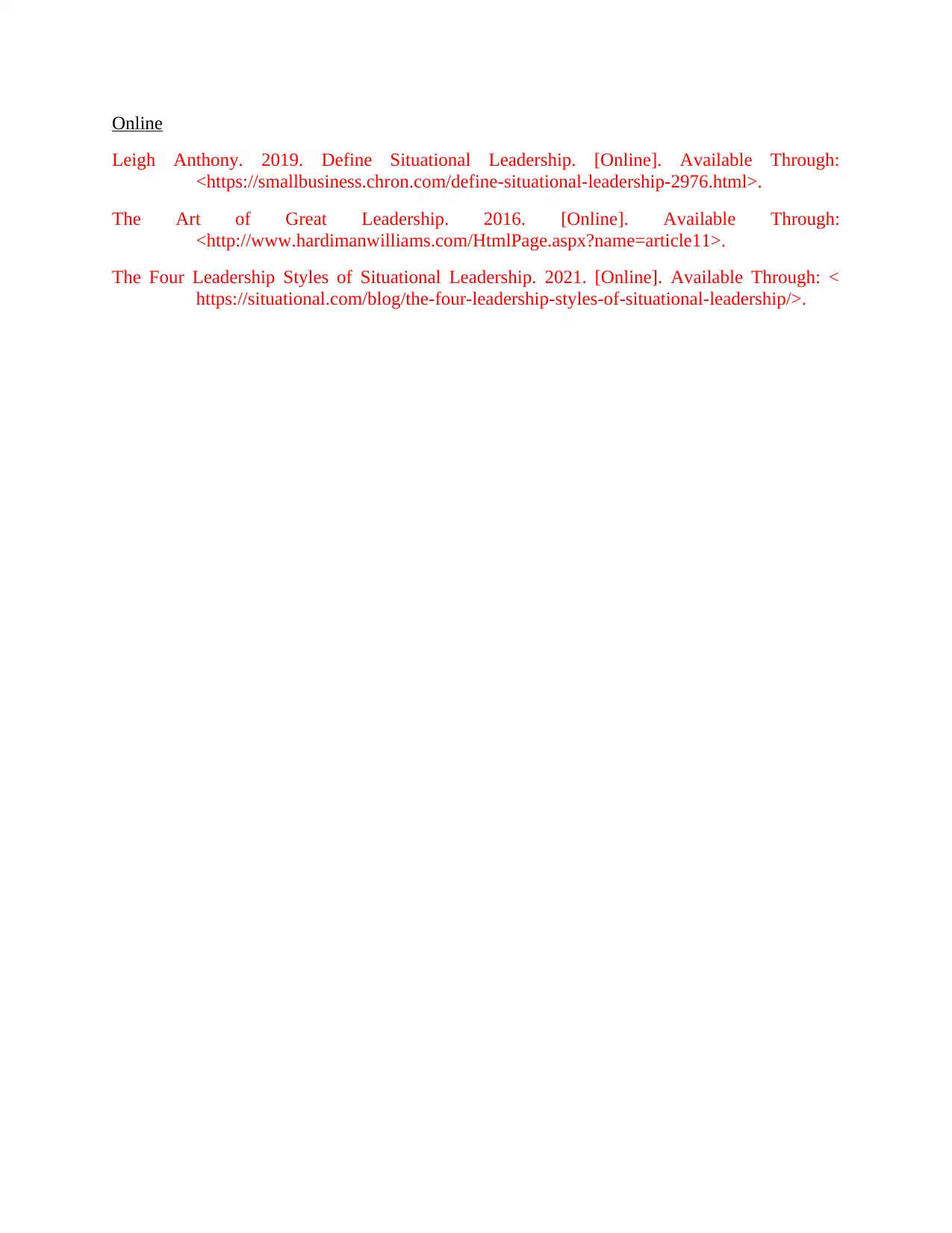
Online
Leigh Anthony. 2019. Define Situational Leadership. [Online]. Available Through:
<https://smallbusiness.chron.com/define-situational-leadership-2976.html>.
The Art of Great Leadership. 2016. [Online]. Available Through:
<http://www.hardimanwilliams.com/HtmlPage.aspx?name=article11>.
The Four Leadership Styles of Situational Leadership. 2021. [Online]. Available Through: <
https://situational.com/blog/the-four-leadership-styles-of-situational-leadership/>.
Leigh Anthony. 2019. Define Situational Leadership. [Online]. Available Through:
<https://smallbusiness.chron.com/define-situational-leadership-2976.html>.
The Art of Great Leadership. 2016. [Online]. Available Through:
<http://www.hardimanwilliams.com/HtmlPage.aspx?name=article11>.
The Four Leadership Styles of Situational Leadership. 2021. [Online]. Available Through: <
https://situational.com/blog/the-four-leadership-styles-of-situational-leadership/>.
⊘ This is a preview!⊘
Do you want full access?
Subscribe today to unlock all pages.

Trusted by 1+ million students worldwide
1 out of 12
Related Documents
Your All-in-One AI-Powered Toolkit for Academic Success.
+13062052269
info@desklib.com
Available 24*7 on WhatsApp / Email
![[object Object]](/_next/static/media/star-bottom.7253800d.svg)
Unlock your academic potential
Copyright © 2020–2025 A2Z Services. All Rights Reserved. Developed and managed by ZUCOL.





